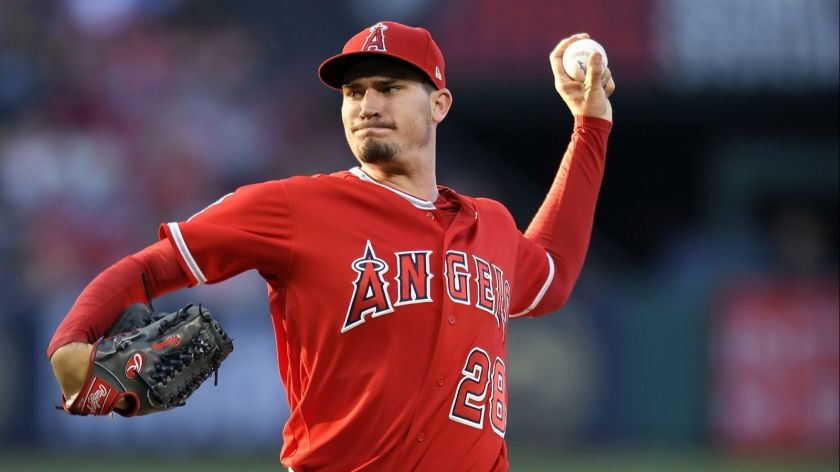
(originally posted 8/4/2021)
This past trade deadline, the New York Yankees made a much anticipated – yet surprising – splash in the market acquiring Chicago Cubs 1B Anthony Rizzo and Texas Rangers OF Joey Gallo. The two bats hope to bolster an injury-riddled (shocker) lineup that currently sits 6.5 games behind the first place Boston Red Sox and 2.5 games out of the second wild card spot (as of August 1).
While Rizzo and Gallo’s arrival has created a sense of excitement that hasn’t existed since April, many fans are still skeptical the Yankees didn’t address a big need: Starting pitching. As I’ve highlighted before, Gerrit Cole has been everything as advertised in his second season in pinstripes. He currently leads the MLB in strikeouts (179), owns a team-high 3.9 WAR, and in many eyes is the current frontrunner for the AL Cy Young award.
Behind him, however, has been a different story. Cole’s supporting cast so far this year has been a combination of Jordan Montgomery, Domingo German, and Jameson Taillon. While the Yankees pitching staff has collectively rallied to the tune of a 3.77 ERA (11th in MLB), 989 K (9th), and opposing batting average of .225 (T-4th), the lack of consistency behind Cole has been a problem. German missed the first 60 games this season due to a domestic violence issue. Free agent acquisition Corey Kluber hasn’t pitched since May 25 due to injury. Luis Severino is still rehabbing from a Tommy John surgery that took place back in February 2020.
Montgomery has enjoyed the best season of his career to date (109.2 IP, 3.56 FIP, 2.5 WAR), but Taillon and German currently sport a FIP over 4.0 (4.35 and 4.31, respectfully). If it weren’t for a couple of back end bullpen blunders, the narrative around this trio of misfits could look a lot differently. However, as of August 1, the Yankees have a 14.5% chance to make the playoffs. With German potentially going to the IL and no guarantee of seeing Kluber or Severino for at least another month, Yankees fans have to wonder: Is the pitching going to be enough?
Enter Andrew Heaney.
Heaney, 30 year old ex-Angel LHP, was one of Cashman’s quieter deadline deals. Most Yankee fans weren’t thrilled about the idea of adding an aging lefty with a 92 mph fastball that’s pitched to the tune of a 5.25 ERA in 94 IP (before his first NY start). It wasn’t an exciting addition by any means, but it could be a critical one for a team that’s struggled to solidify a fifth starter. If Heaney pitches to projections and makes a couple of strategic adjustments, he could end up being a 3+ WAR pitcher.
*Former RHP Masahiro Tanaka only produced 3+ WAR in two of his seven seasons in pinstripes (2016, 2019).
Let’s start with the upside. Heaney currently utilizes a three pitch mix – four seam fastball, curveball, and change up. While his fastball velocity doesn’t jump off the charts (92.0 – 30th percentile MLB), he spins it in the 89th percentile of all MLB arms (2453 RPM). His whiff rate ranks in the 73rd percentile, chase rate ranks in the 91st percentile, and his K% ranks in the 75th percentile.
His curveball is his primary secondary pitch, throwing it 22.3% of the time. While it profiles more like a slider, it’s been very effective against left handed hitters (.152 BAA). It’s currently moving the most it ever has horizontally (7.3”) and has been his best pitch so far in 2021, generating an expected run value (RV) of -2.
Heaney’s change-up has been used exclusively against right handed hitters, throwing just eight of 307 to lefties. It averages 20% more horizontal break than the average MLB change up, moving 17.3”. It generates whiffs 24.3% of the time and has produced an XBA of .227 – the lowest of his three pitches.
Below is the pitch distribution for Heaney’s arsenal. You’re going to notice three different clusters for all three pitches. This, in a lot of ways, is a positive thing. Having three pitches that utilize three different parts of the strike zone is a very effective way to keep hitters off balance.
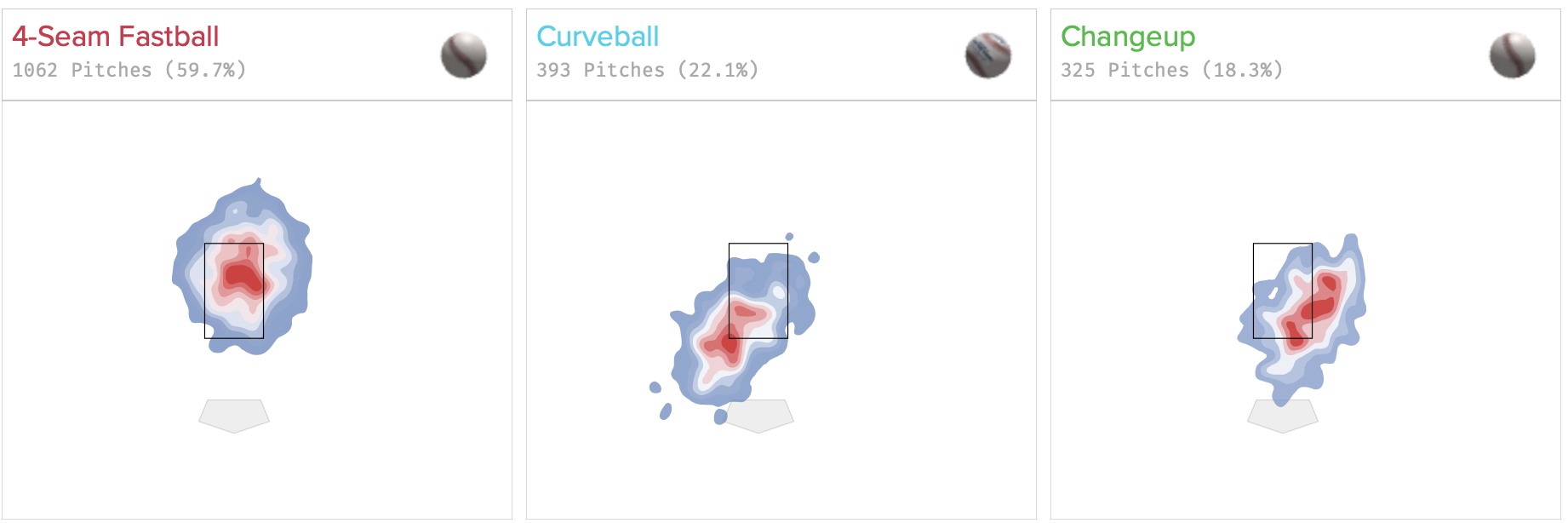
While the ERA has been disappointing so far, it doesn’t tell the whole story. Heaney currently owns a 4.05 FIP, which is a better mark than several notable pitchers this season:
- Kyle Hendricks (4.67 FIP)
- Zack Greinke (4.55 FIP)
- Yusei Kikuchi (4.40 FIP)
ZiPS Projections currently projects Heaney to finish the season with a 3.93 FIP – below his career average of 4.30 – to go along with a 4.15 ERA, 0.9 WAR (currently has 1.4 WAR), and 10.25 K/9. Those numbers would very comfortably solidify Heaney as not just the five guy in the Yankees rotation, but potentially the three (without Severino).
Something else to consider about Heaney is how different he is from anything else New York has. As of now, Montgomery is the only other left handed starting pitcher on staff. At 6’6 228 lbs, Montgomery has had success throwing primarily curveballs (23.9%) from a high arm slot (release height 6.77, extension 6.50). It currently ranks sixth in all of baseball in terms of wCB/C (1.82) and generates a BAA of .177. Heaney also has a curveball that’s been successful this year (.179 BAA), but he does it from a much different arm slot. His average release height is around 5’3. His average release side angle is 3’5. For reference, Josh Hader’s average release height is 5’3 and his release side angle is 3.16.
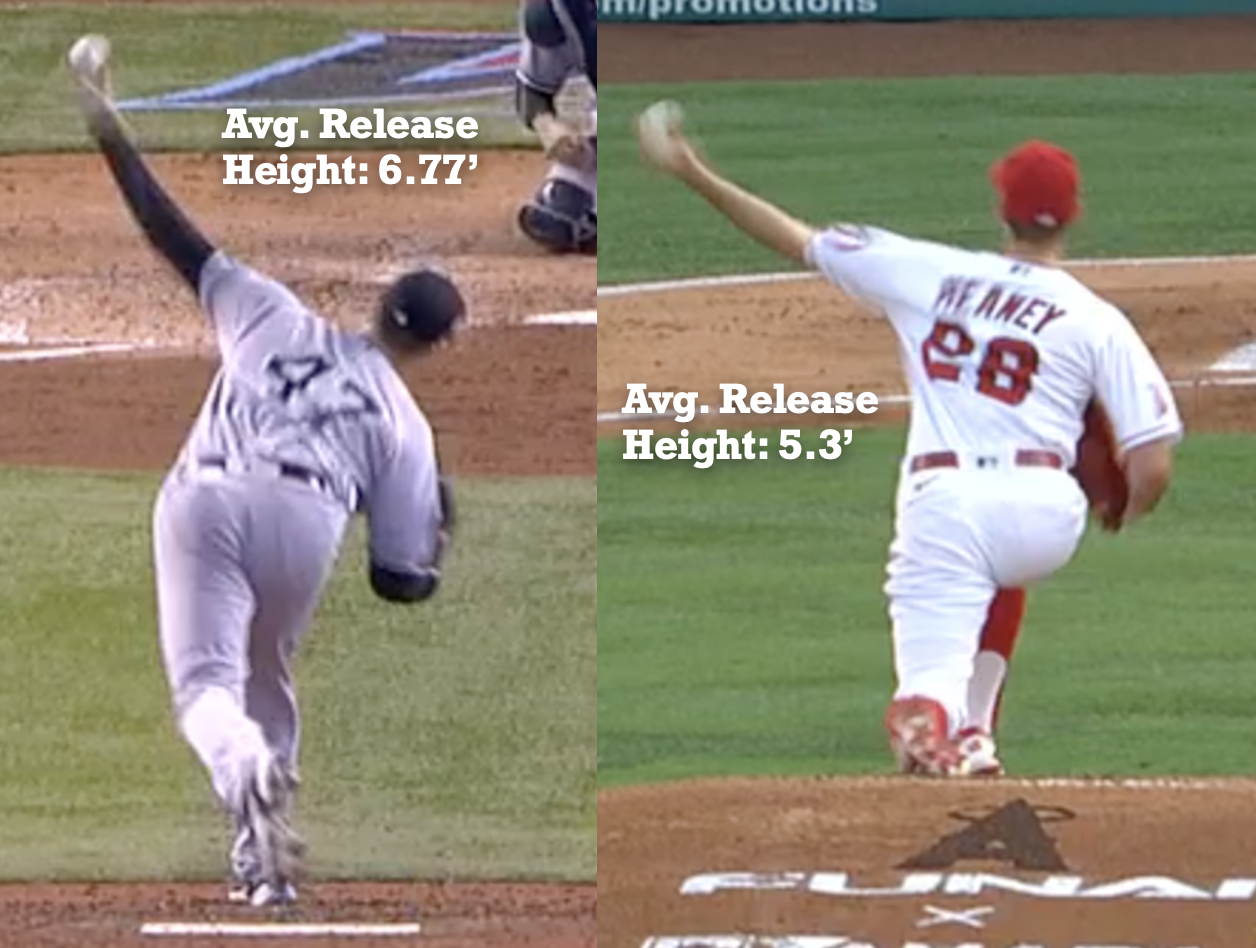
Last postseason, the Tampa Bay Rays bullpen gained a lot of traction due to the wide variance of arm slots they threw at hitters. For similar reasons, I think Heaney’s unique delivery could complement New York’s starting rotation well. You’re getting a very different look every fifth day. His fastball might not be as intimidating as Hader’s, but the slot from which he throws can create a very uncomfortable at-bat – especially for lefties.
As for where Heaney can improve, I’d like to see a couple of things. For one, Heaney has always had a very easy delivery where it doesn’t look like he’s trying to throw very hard at all. This, in a lot of ways, has helped him move to and through good positions of leverage. However, I think it’s almost too easy. There are moments in the delivery where we want to stay loose and relaxed, but there needs to be a bracing moment after foot strike to create for a clean transfer of energy up the chain. Watch his lead leg as he starts to rotate. See how it’s unstable and shifts side to side as it accepts force?
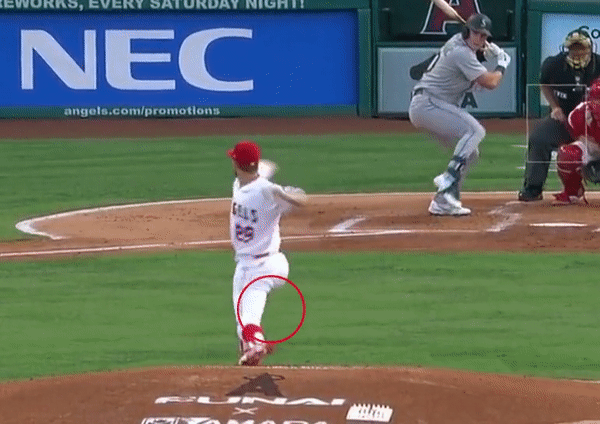
This shows me that Heaney does not have enough stability in his delivery. When the front foot lands, the lead leg needs to firm up and create a stable base for the trunk to rotate around. It doesn’t need to be straight, but you shouldn’t see any added valgus (movement left to right) or flexion (continues to fold forward). A fix here could be as easy as giving him the thought of recoiling after he throws or teaching him how to brace/flex at foot strike. Proximal stability impacts distal performance. In Heaney’s case, I think some proximal stability in his delivery could have a big impact downstream. He might not add three mph, but I think it could have a significant impact on his command of his arsenal.
One of the knocks on Heaney going into the deadline was the location of his four seamers this season. After going through some data, it does seem the distribution of his fastballs has changed. Below are heat maps of his fastballs from 2020, and 2019 (reference above for 2021).
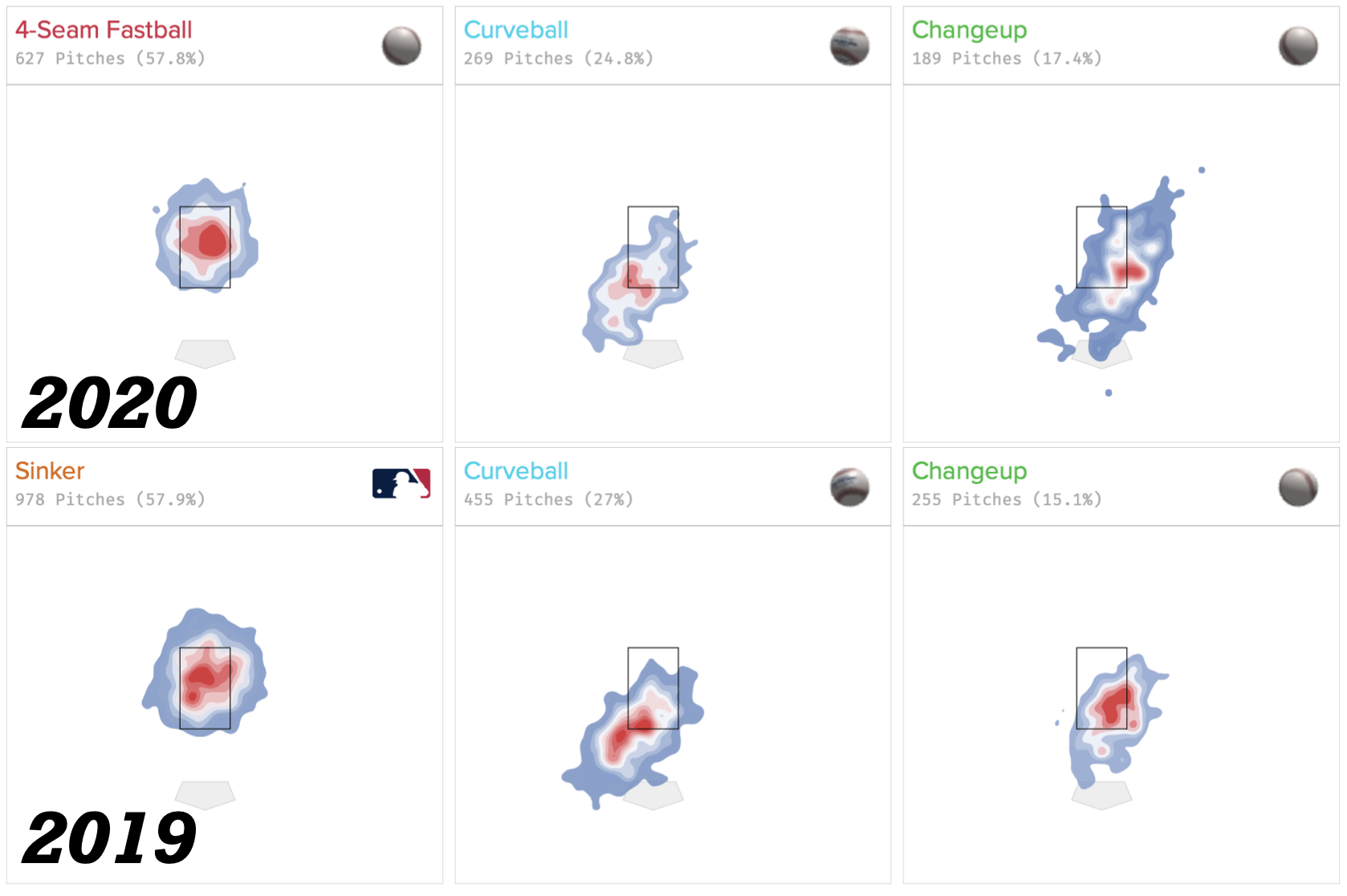
In 2019, Heaney was exclusively using a sinker. It averaged 92.5 mph, spun at 2524 RPM, hitters batted .237 against it, and it generated an expected run value of -3. The pitch distribution was predominately to the glove side. In 2020, Heaney ditched the sinker and went to a four seam fastball. While it averages 15.3” of horizontal break – well above league average – he’s spinning it less in 2021 (2,453 RPM), it’s getting hit harder (.280 BAA, .508 SLG), and he’s throwing it more than he ever has before in his career (59.6%). Instead of a glove side distribution, Heaney is now throwing the pitch more high and arm side. I’d venture to say this was not an intentional decision, but a byproduct of a pitch he does not have great feel for yet.
Remember how we mentioned the problems Heaney’s arm slot should create for lefties? The curveball has created problems, but the fastball has not. In 2020, left handers batted .298 against the four seamer. In 2021, lefties have batted .294 against them. Despite above average spin characteristics and a plus horizontal movement profile, data tells us lefties are not having a tough time with the pitch. Part of the problem could be guys are sitting on the pitch since he’s not throwing any change ups to lefties (8/448). It’s been predominately fastball curveball, with the fastball coming 63% of the time.
Considering Heaney’s lack of results in 2021, I have a couple of potential solutions.
- Throw less fastballs
This one isn’t really rocket science. If the pitch you’re throwing predominately isn’t having much success, why not try throwing it less? The Yankees are no strangers to making guys rely less on their breaking balls (Masahiro Tanaka was a great example). I think we’ll probably see some regression in terms of Heaney’s breaking ball (XBA of .229 exceeds current BAA of .179), but it is a better pitch and it tunnels well off of his fastball. Dropping his fastball usage as little as 5-8% could have a big impact on the arsenal as a whole.
- Bring back the sinker
Heaney’s four seamer does perform very well in terms of horizontal break, but it’s only averaging 1.2” more than what his sinker was in 2019. Considering his slot, the movement profile on his stuff (more H break than V break), and his past success with sinkers (run value of -3 in ’19), I think bringing the sinker back could make a big difference. He threw it harder, spun it better, and hitters performed worse against it. Four seamers just don’t seem like the best fit, here (not really sure why he made the change in the first place?).
- Change the distribution of fastballs
As mentioned above, Heaney’s fastball plot has changed. I don’t think the added cluster of high and arm side fastballs has been particularly beneficial, especially considering his horizontal movement profile on the pitch. The gloveside fastball is a pitch Heaney has not been able to execute well as of late. This could change if he were to go back to the sinker, but I think re-establishing fastball command is going to be critical considering the lack of velocity (avg. 92 mph). Some of this could be cleaned up by creating more proximal stability in his delivery (see above). The less stable we are down low, the tougher it is to rotate well up top with good direction.
- Start throwing more change ups & curveballs to lefties
I think a big reason why Heaney’s fastball has been ineffective against left handers is because he’s really a two pitch pitcher against lefties. The change up has been a non factor. As a result, most guys are probably sitting fastball (since it’s coming 63% of the time) and spitting on the curveball until two strikes. Mixing in more change ups could make these at-bats more unpredictable. His cluster of change ups is mostly low and in, so I’d make sure it was set up well (gloveside, middle-in fastballs) before he starts accidentally running it into barrels. I’d also mix in the curveball more considering the success it’s had against lefties (37.9% whiffs, wOBA against .257).
- Throw less change ups to righties
Don’t be confused by my last point. Throwing the change up more to lefties doesn’t mean throwing it at a 30% clip. It just means showing it enough to keep hitters honest. It’s a different pitch with a different movement profile that gets to a different part of the zone. He should, however, probably throw the pitch less in general to right handers. His curveball, statistically, is his best pitch to righties (BAA .180, SLG .280, wOBA .225). He’s throwing it 17.7% of the time. Heaney’s change up, however, is performing significantly worse against right handers (BAA .252, SLG .437, wOBA .314). He’s throwing it 7% more frequently than his curveball (24%). This probably isn’t a great idea, especially considering Heaney’s change up has a run value this year of 4. You have to throw your most effective pitches in the right situations. This isn’t happening right now for Heaney.
- Throw less fastballs in plus counts
Below is a visual that shows the distribution for Heaney’s pitches by count. The red is fastballs, blue is curveballs, and green is change ups thrown:
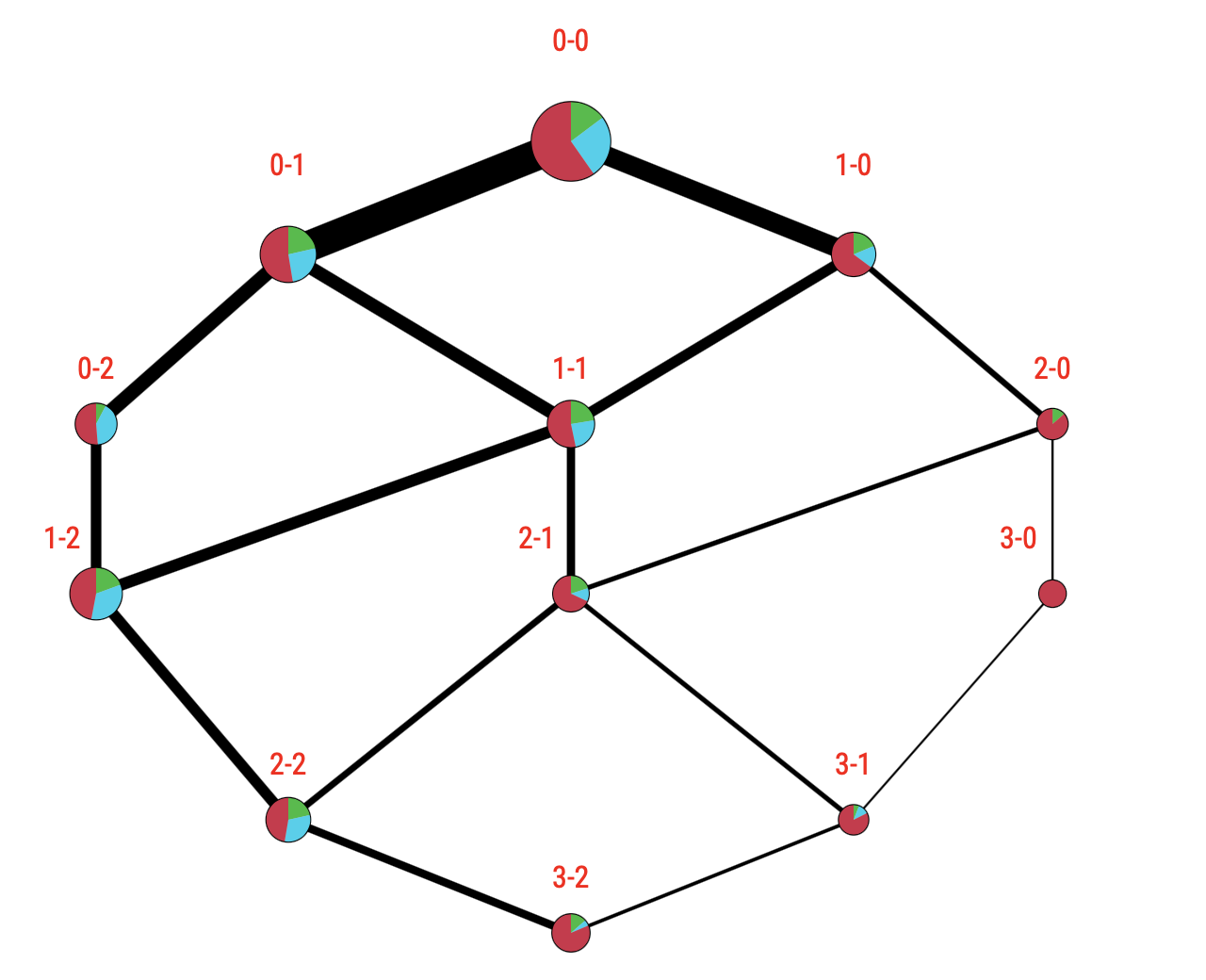
Let’s look at the counts 2-1, 3-1, 1-0, and 2-0. Below are MLB slash lines for those counts:
- 1-0: .341/.344/.613
- 2-0: .360/.359/.661
- 2-1: .349/.351/.614
- 3-1: .364/.698/670
For Heaney, throwing a large percentage of fastballs in these counts is not a great idea. His fastball currently has a run value of 3, hitters slug .538 against it, and it’s getting hit hard 48.2% of the time. While Heaney isn’t the kind of guy that gets behind in counts a lot (career 2.5 BB/9), it’s not a bad idea to start pitching backwards when he does get behind. A couple of bad pitches in the wrong counts is enough to ruin a good outing.
As we’ve seen in Heaney’s first start, my final concern for the left hander is he’s predominately a fly ball pitcher (68%, 18.2 average launch angle). Yankee Stadium isn’t exactly the kindest park when it comes to pitchers managing the long ball. In 2020, it ranked 6th highest in the MLB for park adjusted run production (1.159) and 3rd in homers (1.565). I think I’ve laid out multiple strategies in here that could help manage this, but don’t be surprised if he gets burned by the long ball a few more times at home.
Andrew Heaney might not be Cashman’s most exciting deadline pick up of recent memory, but it could pay off with a couple of minor adjustments. He won’t be the reason why they miss playoffs, but he could be one of the reason why they make it.
